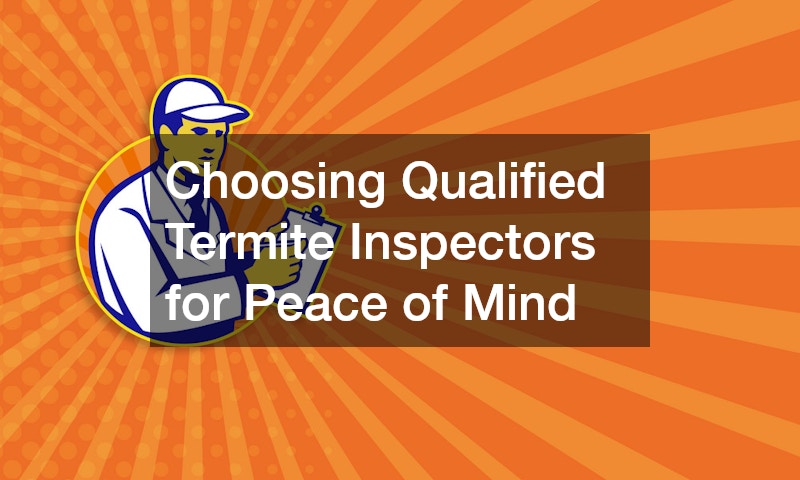Protecting a home from long-term structural damage often starts with what lies beneath the surface. Termite activity can remain unnoticed for years, quietly compromising the integrity of timber elements within walls, floors and foundations. What appears to be a well-maintained property can, in fact, be at risk of costly deterioration if inspections are not carried out with precision and care.
In this environment, the expertise of termite inspectors becomes vital. The right inspection not only identifies current infestations but can also highlight areas of vulnerability before damage occurs.
When it comes to safeguarding the value and stability of a property, choosing the right professional is a decision that demands attention to detail and a strong understanding of what true qualifications involve.
Qualifications & Standards That Matter
Not all termite inspectors operate to the same standard, and that makes a significant difference in the quality of the service provided. A properly trained professional should hold relevant licensing and accreditation that aligns with the standards set by local authorities and industry bodies. In most cases, this means holding a recognised pest control licence with specific training in timber pest inspection and identification.
The best inspectors also undertake continued professional development to stay current with advances in pest behaviour, inspection technology and regulatory changes. These commitments reflect a professional’s dedication to accuracy and reliability. Without appropriate qualifications, inspections may miss critical warning signs or fail to comply with best practice reporting protocols.
Reports from underqualified inspectors may be vague, incomplete or misleading, leaving homeowners with a false sense of security. On the other hand, comprehensive reports from trained professionals are detailed, clear and useful for both current property maintenance and future resale.
Tools & Technology That Improve Detection
Modern inspection methods have evolved far beyond a visual scan of timber surfaces. While experience remains central to identifying risk areas, today’s most reliable inspections are enhanced by technology. Tools such as moisture meters, thermal imaging devices and sounding instruments allow for the detection of hidden issues that would not be visible to the naked eye.
Technology plays a supportive role in ensuring nothing is overlooked during the inspection process. Moisture readings, for example, can indicate conditions favourable to termite activity, while infrared scanning may reveal temperature differences that suggest movement or nesting behind walls. These tools, in the hands of a skilled professional, significantly increase the accuracy and reliability of the final report.
The inclusion of photos, diagrams and clear risk assessments in the inspector’s documentation is another key factor in evaluating the quality of the service provided. Homeowners are better placed to take action when information is presented in a way that is both thorough and understandable.
Communication & Reporting You Can Trust
Beyond technical ability, the quality of communication from a chosen inspector is just as important. A good professional will take time to explain their findings, discuss potential solutions and answer questions with clarity. Reports should be delivered promptly, usually within 24 to 48 hours of the inspection, and should meet the standards outlined in Australian Standard AS 4349.3 for timber pest inspections.
This level of communication is especially important for prospective homebuyers who may need to make time-sensitive decisions based on an inspection report. A delay or poorly written report can disrupt the buying process or lead to under-informed negotiations. Sellers, too, can benefit from professional documentation, as it offers reassurance to buyers and demonstrates proactive maintenance.
Clarity in findings, transparency in recommendations and a willingness to walk clients through each section of the report signal a professional who understands the importance of peace of mind.
Why It Pays to Do Your Research
Finding the right professional may take a little more time, but the benefits are well worth the effort. Referrals from trusted tradespeople, reviews from other homeowners and verification through industry directories can all help ensure you are selecting from a pool of qualified individuals.
While price is an understandable consideration, it should not be the primary deciding factor. Low-cost inspections can sometimes signal shortcuts in the process or reporting. A thorough, reputable service may come at a slightly higher price point but offers long-term value through accuracy and confidence in the result.
In the long run, having confidence in the inspection process helps homeowners avoid unexpected repair costs, manage risks proactively and maintain the structural integrity of their most valuable asset.
Making informed choices when it comes to home maintenance begins with selecting the right professionals. When faced with the potential damage termites can cause, relying on skilled and qualified termite inspectors is not just a convenience—it is a necessity.
Through proper training, use of modern tools and clear communication, a capable inspector offers far more than just a check-box service. They provide the peace of mind that comes from knowing your home has been thoroughly assessed by someone who understands what to look for and how to present it. As a result, homeowners are better equipped to protect their investment and plan for the future with confidence.



